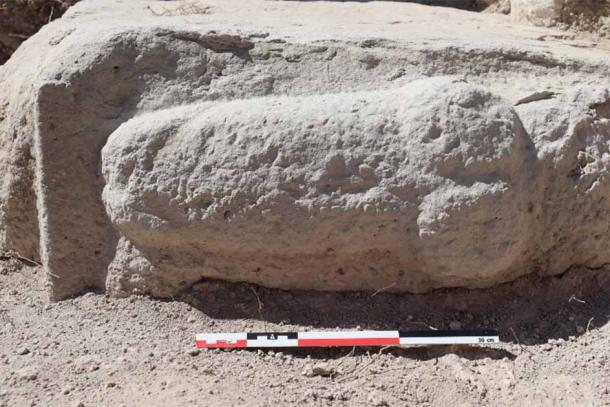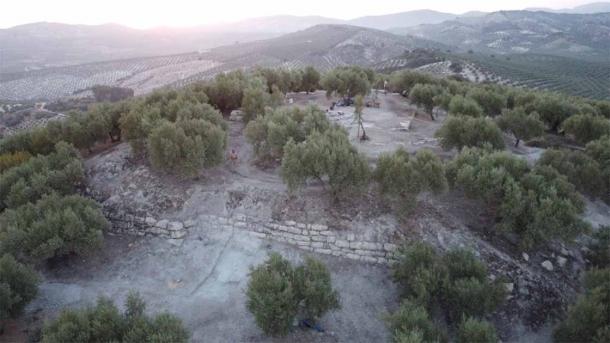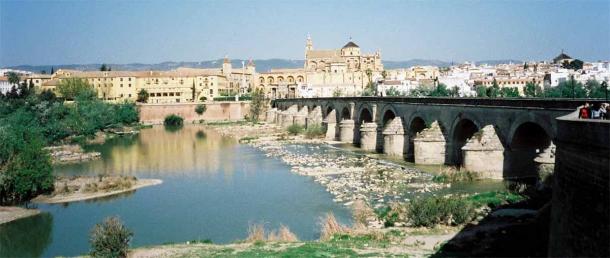
Large Phallic Carving from Roman Era Gets Public Exposure in Spain
A giant 18-inch (1.5 foot) phallic carving from the Roman era has been discovered in the city of Córdoba in Andalusia, Spain. It was part of an ancient Roman settlement known as El Higuerón, a region the Romans took over in 206 BC, replacing the Iberians. A tower-like building was erected (pun intended) on the ruins of an Iberian settlement, and the phallic carving was found on one of the cornerstones of the tower.
- Earliest known erotic graffiti found on an Aegean island
- Dirty Pictures Discovered in an 1,800-Year-Old Men’s Loo Hold the Seeds Of ‘Locker Room’ Talk

This recently discovered phallic carving in a limestone tower is certainly eye-catching! (Courtesy of Museo Histórico Local de Nueva Carteya)
The Ginormous Phallus and Roman Phallocentrism
On social media, they wrote, “Today we have had a find that has quickly become the center of attention in the excavation. It is a phallic relief that has appeared on one of the ashlars that form the northeast corner of the Roman tower. This type of representation was common at the time, despite the view that can be had today.”
In Roman society, the phallus was a symbol of masculinity, granting protection, power, and prestige, along with good fortune. Thus, its representation has been found scattered throughout the Roman Empire, as a token of the Roman state’s protection ( sacra romana). There is a large concentration of phallic symbols on the Hadrian Wall in England, with 59 known etchings of male genitalia found here.
In pagan faiths as well, the phallus was associated with natural fecundity, with the phallic symbols representing the Fascinus, the god of fertility, who warded off the ‘evil eye’. What was not common was the massive size of the phallic carving found, reports El Pais.
Project director Andrés Roldán, University of Extremadura and Director of the Historical Museum of Nueva Carteya said, “It was common to put them [phallic carvings] on the facades of houses, and soldiers carried small phallic amulets as symbols of virility. But this one is unusually large. We are currently researching whether one of similar dimensions has been previously found.”
- Roman Graffiti Shows Carved Phallus With Insult Found at Vindolanda Fort
- Rare Ancient Millstone Found Decorated With A Roman Phallus Carving

An aerial view of the excavation site where the phallic carving was uncovered, in Córdoba, Spain (Courtesy of Museo Histórico Local de Nueva Carteya)
The Tower and the El Higuerón Site
The focus is now on the building itself, to excavate it and the ruins that lie below it. The sturdy, terraced walls supported a tower-shaped edifice with a still unknown function. A report by The Daily Mail stated that excavations on the El Higuerón site began in 1966 and 1968, coinciding with the discovery of the first Iberian settlement.
The Romans had destroyed the military fortifications, and in their place, built their own, using the ruins as foundations for the new constructions – including the 65 x 55 foot (20 x 17 meters) tower-shaped building. The excavations show perimeter walls 1.8 meters (5.9 feet) thick, with floors made of large blocks of limestone.
The archaeologists speculate the presence of underground storerooms for agricultural produce and construction materials. It was probably used by the Romans for agricultural purposes until the 1st century BC, but then abandoned under the Flavian dynasty.
The Moors conquered Iberia in the early 8th century, crossing the Strait of Gibraltar through Northern Africa. They renovated the building, removed the storerooms, and further fortified the access points. Finally, the building was sacked and abandoned when the Christians drove out the Moors in the 1200s.
In a detailed study of the tower and local fortified precincts in the area published in 1970, there seemed to be a linkage suggested between these buildings and the Carthaginian general, Hannibal. Hannibal had marched his army through southern Iberia at the end of the 3rd century BC. The paper was disproved later, with the links proved to be Roman.
Now the team of archaeologists is primarily occupied with excavating and examining an access point through one of the tower’s facades, and cleaning the perimeter wall, which is one of the “more massive features of the site”. It remains to be seen if more phallic carvings of massive male members will be discovered.

There are many reminders of Cordoba’s Roman past, like this bridge from the 1st century BC that remains in use today (Jim Linwood / CC BY 2.0)
Of the Roman occupation, Andrés Roldán descriptively concluded that, “They razed the settlement and used the ancient Iberian fortifications as foundations [for the new buildings]. The various Iberian edifices in the area, such as the one in Nueva Carteya, were built on strategic topographical points and suggest a much more complex history than one would expect from these archaeological sites.”
Top image: A phallic carving on the cornerstone of a Roman-era military site in southern Spain Source: Ayuntamiento de Nueva Carteya
By Sahir Pandey
References
Heritage Daily. 2022. Giant Phallic Carving from Roman Period found during Excavations in Cordoba. Available at: https://www.heritagedaily.com/2022/08/giant-phallic-carving-from-roman-period-found-during-excavations-in-cordoba/144522.
Jackson, F. 2022. Rock Hard! 'Unusually Large' Penis Carving is uncovered by Archaeologists on the Cornerstone of a Roman Tower during Excavations in Southern Spain. Available at: https://www.dailymail.co.uk/sciencetech/article-11145125/Unusually-large-penis-carving-uncovered-Roman-tower-excavations-southern-Spain.html.
Malinsky, B. 2022. Rock & a Hard Place: Huge 18-inch Penis Sculpture found by Stunned Archaeologists on Dig at Roman Villa. Available at: https://www.thescottishsun.co.uk/news/9360991/penis-ruins-roman-villa/.
Olaya, V.G. 2022. Archaeologists Discover one of the Largest Phallic Sculptures of Ancient Rome. Available at: https://english.elpais.com/culture/2022-08-25/archaeologists-discover-one-of-the-largest-phallic-sculptures-of-ancient-rome.html.
















Comments
Probably will make the news in some places with a blurred or pixelated image, because for some people it seems like seeing a penis, even one poorly carved in stone can prove as fatal as looking at an image of Ghatanothoa.
The buried ruins are certainly pre-Roman, but that crude carving is probably post-Roman, maybe even post-modern! ;) But that said, you would like to have seen the Greek statues before their manhood was broken off at the base, leaving only enough there to carve a little button. A joke to somebody long ago. Many have a hole there, which suggests that there may have been a fountain aspect to them, in their gymnasiums ...long before the Sumerians and Romans arrived and made everybody cover up.
Nobody gets paid to tell the truth.